The following plants are favorites among native Northwestern bees. We are in Zone 8.
Bloom winter through early spring (February through April)
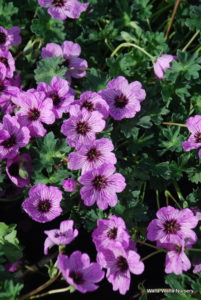 Vine maple (Acer circinatum): Native, deciduous large shrub or small tree that can be trained to a single or multi-trunked form. Good as an understory plant under tall evergreens.
Vine maple (Acer circinatum): Native, deciduous large shrub or small tree that can be trained to a single or multi-trunked form. Good as an understory plant under tall evergreens.
Symmetrically-lobed and toothed leaves, soft green sometimes tinged with red in spring, turning to yellow/orange/red in the fall. Dainty red and white flowers adorn bare branches in early spring. Grows as single or multi-stemmed large shrub/small tree; bark greenish to red, with tiered branching reminiscent of Japanese Maples. Best in acidic soil rich in organic matter, with regular water and protection from afternoon sun.
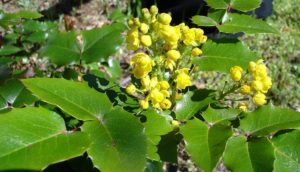 Tall Oregon grape (Berberis aquifolium, formerly Mahonia): The Oregon State flower, this native evergreen shrub busts out with huge can’t-miss-them clusters of yellow flowers. Grows best in partial sun – though some species can thrive in full shade to full sun – rich acidic soil, and to moist to dry conditions. Avoid planting Oregon grape in soil that is compacted, wet, or too alkaline; plants should also be protected from winter winds.
Tall Oregon grape (Berberis aquifolium, formerly Mahonia): The Oregon State flower, this native evergreen shrub busts out with huge can’t-miss-them clusters of yellow flowers. Grows best in partial sun – though some species can thrive in full shade to full sun – rich acidic soil, and to moist to dry conditions. Avoid planting Oregon grape in soil that is compacted, wet, or too alkaline; plants should also be protected from winter winds.
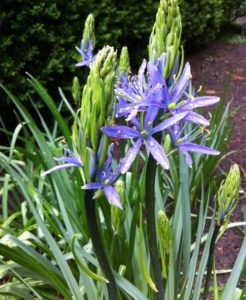 Camas (Camassia spp.): A native bulb with tall foliage and an even taller stalk of blue flowers. Members of the lily family, Camas have the signature strap-like leaves, with the flowering stem rising above the graceful cascade of leaves. Tolerant of many soil types including heavy clay. They like their feet wet in winter and early spring, but need to dry out after flowering, much like most other native bulbs. Sun/Pt Shade.
Camas (Camassia spp.): A native bulb with tall foliage and an even taller stalk of blue flowers. Members of the lily family, Camas have the signature strap-like leaves, with the flowering stem rising above the graceful cascade of leaves. Tolerant of many soil types including heavy clay. They like their feet wet in winter and early spring, but need to dry out after flowering, much like most other native bulbs. Sun/Pt Shade.
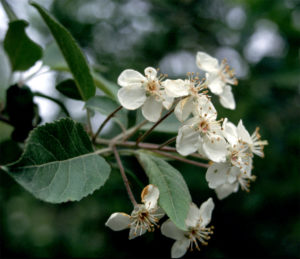 Crabapple (Malus fusca): Deciduous tree with masses of pink or white blooms, followed by red berries. Our only native crabapple is a good large shrub/small tree for attracting birds to the garden. One of its advantages to gardeners in this region is its tolerance of heavy clay soils and winter wet weather – it would be a good candidate to plant at a bioswale or disconnected downspout. Its abilities as a “wetlander” give it an important edge over showier crabapples in certain settings. Once established, it isn’t adverse to drier conditions in the summertime, so its love of wetter situations doesn’t have to be maintained year-round. Full sun suits it best, but it is tolerant of partial shade (though fruit production might diminish a bit with less sun)
Crabapple (Malus fusca): Deciduous tree with masses of pink or white blooms, followed by red berries. Our only native crabapple is a good large shrub/small tree for attracting birds to the garden. One of its advantages to gardeners in this region is its tolerance of heavy clay soils and winter wet weather – it would be a good candidate to plant at a bioswale or disconnected downspout. Its abilities as a “wetlander” give it an important edge over showier crabapples in certain settings. Once established, it isn’t adverse to drier conditions in the summertime, so its love of wetter situations doesn’t have to be maintained year-round. Full sun suits it best, but it is tolerant of partial shade (though fruit production might diminish a bit with less sun)
Bloom spring through early summer (April through June)
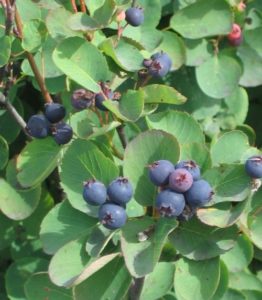 Western serviceberry (Amelanchier alnifolia spp.): Native deciduous shrub or small tree with star-shaped white flowers followed by maroon-purple berries. These tiny berries were a staple of Pacific Northwest Indian tribes, and can be eaten fresh, cooked or dried. In addition, this small tree / tall multi-stemmed shrub is attractive with something of interest every season of the year, so is garden-worthy in its own right. The birds will be happy to enjoy the fruit, too.
Western serviceberry (Amelanchier alnifolia spp.): Native deciduous shrub or small tree with star-shaped white flowers followed by maroon-purple berries. These tiny berries were a staple of Pacific Northwest Indian tribes, and can be eaten fresh, cooked or dried. In addition, this small tree / tall multi-stemmed shrub is attractive with something of interest every season of the year, so is garden-worthy in its own right. The birds will be happy to enjoy the fruit, too.
 Borage (Borago officinalis): An annual herb with fuzzy foliage and delightful clusters of blue flowers; will reseed year to year. An ancient plant that is used for medicinal purposes. Edible.
Borage (Borago officinalis): An annual herb with fuzzy foliage and delightful clusters of blue flowers; will reseed year to year. An ancient plant that is used for medicinal purposes. Edible.
 California lilac (Ceanothus spp.): Of the fifty or so species that are native to North America, there are a little over a half–dozen native to Oregon. (Many others are exclusively native to California, which is why the common name is often known as California Lilac.) There are evergreen and deciduous species of Ceanothus. Of the evergreen varieties, leaves tend to be small, rounded to oval, toothed and somewhat leathery in texture, usually dark green. Leaves of deciduous varieties are larger, softer in texture, rounded to oval and slightly toothed. Flowers of both types are generally showy, sometimes fragrant clusters or sprays of tiny flowers, ranging from creamy white to electrically–bright blue. Grows in full sun to partial shade, with excellent drainage. Prefers lean soil conditions. Most are drought tolerant, to the point that they balk at summer water. These plants can be “killed with kindness” and too much water or fertilizer can result in a much shortened lifespan.
California lilac (Ceanothus spp.): Of the fifty or so species that are native to North America, there are a little over a half–dozen native to Oregon. (Many others are exclusively native to California, which is why the common name is often known as California Lilac.) There are evergreen and deciduous species of Ceanothus. Of the evergreen varieties, leaves tend to be small, rounded to oval, toothed and somewhat leathery in texture, usually dark green. Leaves of deciduous varieties are larger, softer in texture, rounded to oval and slightly toothed. Flowers of both types are generally showy, sometimes fragrant clusters or sprays of tiny flowers, ranging from creamy white to electrically–bright blue. Grows in full sun to partial shade, with excellent drainage. Prefers lean soil conditions. Most are drought tolerant, to the point that they balk at summer water. These plants can be “killed with kindness” and too much water or fertilizer can result in a much shortened lifespan.
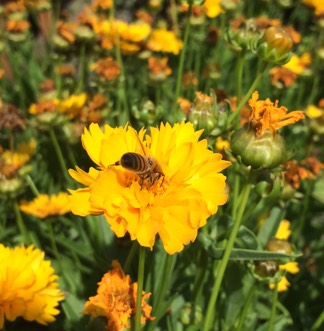 Tickseed (Coreopsis spp.): Coreopsis is a tough perennial that thrives in full sun in the cottage boarder, intense parking strip or mixed container. A versatile plant which combines well with echinacea, grasses and perovskia. The abundant flowers come in a broad array of colors and combinations from creamy yellow, radiant oranges and reds, to vibrant hot pink and are generally about 1-2” diameter each. Many species grow to around 2-3’ tall and wide, although some grow as small as 8” and others over 5’. The leaves vary from simple, dissected to ferny
Tickseed (Coreopsis spp.): Coreopsis is a tough perennial that thrives in full sun in the cottage boarder, intense parking strip or mixed container. A versatile plant which combines well with echinacea, grasses and perovskia. The abundant flowers come in a broad array of colors and combinations from creamy yellow, radiant oranges and reds, to vibrant hot pink and are generally about 1-2” diameter each. Many species grow to around 2-3’ tall and wide, although some grow as small as 8” and others over 5’. The leaves vary from simple, dissected to ferny
 Geranium (Geramium spp.): Geraniums are known for the breadth of conditions they can tolerate, from full sun to dry shade, as well as the ease with which they can be grown. They are a favorite with bees and butterflies. Flower colors ranging from white, blue, purple and a multitude of pinks. In addition, many of the flowers have interesting variegation, veining and spotting.
Geranium (Geramium spp.): Geraniums are known for the breadth of conditions they can tolerate, from full sun to dry shade, as well as the ease with which they can be grown. They are a favorite with bees and butterflies. Flower colors ranging from white, blue, purple and a multitude of pinks. In addition, many of the flowers have interesting variegation, veining and spotting.
Leaf colors range from green, green with dark markings, green with yellow markings, as well as brown. Geraniums can be fun and easy for any kind of gardener and garden condition. They can liven up a rock garden or add texture and color to a romantic rose garden. In addition, many work well in dappled shade conditions underneath deciduous trees. They combine beautifully with shasta daisies, peonies and iris.
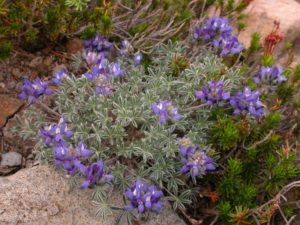 Lupine (Lupinus spp.): Tall spikes of flowers make this perennial a distinctive plant in the garden. The most common is blue, but hybrids run the gamut from pink and red yellow and white and even bi-colors.
Lupine (Lupinus spp.): Tall spikes of flowers make this perennial a distinctive plant in the garden. The most common is blue, but hybrids run the gamut from pink and red yellow and white and even bi-colors.
Bloom mid- to late summer (July through September)
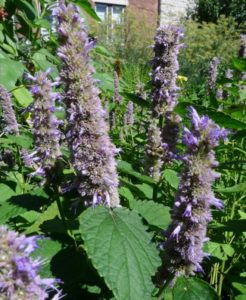 Blue giant hyssop (Agastache foeniculum and spp.) Agastache from north-central North America grows 18 in. to 4 ft. tall and 2 ft. wide with lilac-blue flowers. The foliage is anise, or licorice scented and used to make tea.
Blue giant hyssop (Agastache foeniculum and spp.) Agastache from north-central North America grows 18 in. to 4 ft. tall and 2 ft. wide with lilac-blue flowers. The foliage is anise, or licorice scented and used to make tea.
This species is more tolerant of winter wet and cold than other species. It also blooms the first year when planted from seed and will reseed freely.
 California poppy (Eschscholzia californica): Poppies are an important pollen source and attract numerous bees to your yard, so they often benefit any plant needing pollination to produce, such as tomatoes, fruits, etc.
California poppy (Eschscholzia californica): Poppies are an important pollen source and attract numerous bees to your yard, so they often benefit any plant needing pollination to produce, such as tomatoes, fruits, etc.
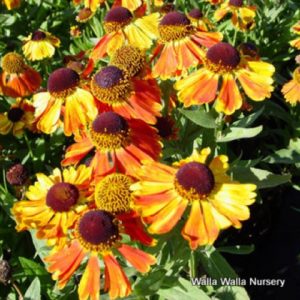 Sneezeweed (Helenium autumnale): Don’t let the name Sneezeweed scare you away from this stunning bloomer. The name came from the Native Americans use of the plant to make snuff. Heleniums are a gorgeous flower for the late summer/ early fall garden. They are covered in dozens of 2-3″ flowers July-September and can rebloom in October. Not only do Heleniums look good in the garden but they are also as great cut flowers and good for bees. They are easy to grow and reliable in any fertile soil and tolerate quite a bit of moisture (a good candidate for the moist to mesic area of a rain-garden). They blend perfectly with grasses, bee balm, yarrow and other late season bloomers.
Sneezeweed (Helenium autumnale): Don’t let the name Sneezeweed scare you away from this stunning bloomer. The name came from the Native Americans use of the plant to make snuff. Heleniums are a gorgeous flower for the late summer/ early fall garden. They are covered in dozens of 2-3″ flowers July-September and can rebloom in October. Not only do Heleniums look good in the garden but they are also as great cut flowers and good for bees. They are easy to grow and reliable in any fertile soil and tolerate quite a bit of moisture (a good candidate for the moist to mesic area of a rain-garden). They blend perfectly with grasses, bee balm, yarrow and other late season bloomers.
Showy tarweed (Madia elegans): This yellow-blooming native plant is an annual herb, and a beautiful one at that. Flowers are centered with a red ring.
Catmint (Nepeta x faassenii): A pretty, pest-free perennial with gray-green, fragrant foliage and spikes of small flowers in shades of blue and purple. Zone 5.
Russian sage (Perovskia atriplicifolia): Airy clouds of lavender flowers distinguish this heat-loving, low-water perennial. Zone 4.
Phacelia (Phacelia spp.): A fast-growing perennial with fernlike foliage topped with fascinating blue flowers that unfurl in a fiddlehead shape. Zone 7.
Stonecrop (Sedum spp.): There are any species of this succulent, both tall and low. Groundcovers normally put out small yellow flowers; tall have blooms in shades of pink. Drought tolerant. Various hardiness, some as low as Zone 4.
Bloom late summer to fall (September through November)
Michaelmas daisy (Aster amellus): An easy-to-grow perennial with daisylike flowers in various shades of purple and pink. There’s even a white one. Zone 4.
Goldenrod (Solidago canadensis): A native perennial with abundant sprays of sunshine yellow. Zone 4.
Douglas aster (Symphyotrichum subspicatum): An adaptable, very-long blooming native perennial with lavender-blue, daisylike flowers. Zone 5.